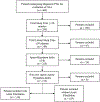Positional obstructive sleep apnea in patients with atrial fibrillation
- PMID: 35538180
- PMCID: PMC10349247
- DOI: 10.1007/s11325-022-02625-y
Positional obstructive sleep apnea in patients with atrial fibrillation
Abstract
Purpose: Obstructive sleep apnea (OSA) is a common, potentially modifiable condition implicated in the pathogenesis of atrial fibrillation (AF). The presence and severity of OSA is largely sleep position-dependent, yet there is high variability in positional dependence among patients with OSA. We investigated the prevalence of positional OSA (POSA) and examined associated factors in patients with AF.
Methods: We recruited an equal number of patients with and without AF who underwent diagnostic polysomnography. Patients included had ≥ 120 min of total sleep time with 30 min of sleep in both supine and lateral positions. POSA was defined as an overall apnea hypopnea index (AHI) ≥ 5/h, supine AHI (sAHI) ≥ 5/h, and sAHI greater than twice the non-supine AHI. POSA prevalence was compared in patients with and without AF adjusting for age, sex, OSA severity, and heart failure.
Results: A total of patients (male: 56%, mean age 62 years) were included. POSA prevalence was similar between the two groups (46% vs. 39%; p = 0.33). Obesity and severe OSA (AHI ≥ 30/h) were associated with low likelihood of POSA (OR [CI] of 0.17 [0.09-0.32] and 0.28 [0.12-0.62]). In patients with AF, male sex was associated with a higher likelihood of POSA (OR [CI] of 3.16 [1.06-10.4]).
Conclusion: POSA is common, affecting more than half of patients with AF, but the prevalence was similar in those without AF. Obesity and more severe OSA are associated with lower odds of POSA. Positional therapy should be considered in patients with mild OSA and POSA.
Keywords: Atrial fibrillation; Obstructive sleep apnea; Positional sleep apnea.
© 2022. The Author(s), under exclusive licence to Springer Nature Switzerland AG.
Conflict of interest statement
Figures


Similar articles
-
A systematic comparison of factors that could impact treatment recommendations for patients with Positional Obstructive Sleep Apnea (POSA).Sleep Med. 2018 Oct;50:145-151. doi: 10.1016/j.sleep.2018.05.012. Epub 2018 May 30. Sleep Med. 2018. PMID: 30055481
-
Prevalence and characteristics of positional sleep apnea in the HypnoLaus population-based cohort.Sleep Med. 2018 Aug;48:157-162. doi: 10.1016/j.sleep.2018.02.011. Epub 2018 Mar 9. Sleep Med. 2018. PMID: 29957486
-
Sex- and age-differences in supine positional obstructive sleep apnea in children and adults.Sleep Breath. 2025 Feb 17;29(1):106. doi: 10.1007/s11325-025-03252-z. Sleep Breath. 2025. PMID: 39961893 Free PMC article.
-
Effectiveness of mandibular advancement devices in the treatment of obstructive sleep apnea and the impact of different body positions on treatment: A systematic review and meta-analysis.Sleep Med. 2024 Jan;113:275-283. doi: 10.1016/j.sleep.2023.11.1134. Epub 2023 Dec 5. Sleep Med. 2024. PMID: 38071926
-
Positional therapy in the management of positional obstructive sleep apnea-a review of the current literature.Sleep Breath. 2018 May;22(2):297-304. doi: 10.1007/s11325-017-1561-y. Epub 2017 Aug 29. Sleep Breath. 2018. PMID: 28852945 Review.
Cited by
-
Prevalence and characteristics of positional obstructive sleep apnea in a Saudi population-based cohort.Medicine (Baltimore). 2024 Nov 15;103(46):e40455. doi: 10.1097/MD.0000000000040455. Medicine (Baltimore). 2024. PMID: 39560588 Free PMC article.
-
New Insights of Cardiac Arrhythmias Associated with Sleep-Disordered Breathing: From Mechanisms to Clinical Implications-A Narrative Review.J Clin Med. 2025 Mar 12;14(6):1922. doi: 10.3390/jcm14061922. J Clin Med. 2025. PMID: 40142730 Free PMC article. Review.
-
Linking Sleep Disorders to Atrial Fibrillation: Pathways, Risks, and Treatment Implications.Biology (Basel). 2024 Sep 25;13(10):761. doi: 10.3390/biology13100761. Biology (Basel). 2024. PMID: 39452070 Free PMC article. Review.
References
-
- Go AS, Hylek EM, Phillips KA, et al. (2001) Prevalence of Diagnosed Atrial Fibrillation in Adults: National Implications for Rhythm Management and Stroke Prevention: the AnTicoagulation and Risk Factors In Atrial Fibrillation (ATRIA) Study. JAMA 285:2370–2375. 10.1001/jama.285.18.2370 - DOI - PubMed
MeSH terms
Grants and funding
LinkOut - more resources
Full Text Sources
Medical

